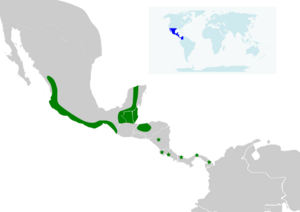Mexican dog-faced bat facts for kids
Quick facts for kids Mexican dog-faced bat |
|
|---|---|
| Conservation status | |
| Scientific classification | |
| Genus: |
Cynomops
|
| Species: |
mexicanus
|
 |
|
| Synonyms | |
|
|
The Mexican dog-faced bat (Cynomops mexicanus) is a cool type of bat that lives in Central America. It's part of a family called Molossidae, which are also known as "free-tailed bats." You can find this bat from Nayarit in Mexico all the way down to Costa Rica. They usually live in places that are up to 1500 meters (about 4,900 feet) high. These bats like to hang out in dry and wet forests, often close to small ponds or rivers.
About Its Name and Family
Scientists first described the Mexican dog-faced bat in 1967. Back then, they thought it was just a type of Greenhall's dog-faced bat (Cynomops greenhalli). So, its first scientific name was Molossops greenhalli mexicanus. Later, scientists decided that Cynomops was its own group, not just a smaller part of Molossops. In 2002, they finally decided that the Mexican dog-faced bat was a full species on its own. Its species name, "mexicanus", is a Latin word. It simply means "from Mexico," which makes sense because that's where it was first found.
What It Looks Like
The Mexican dog-faced bat is a fairly large free-tailed bat. Its total length, from nose to tail, is about 90 to 107 millimeters (around 3.5 to 4.2 inches). Its forearms, which are like its "arms" for flying, are about 34.6 to 36.8 millimeters long (1.3 to 1.4 inches). The tail itself is about 28 to 33 millimeters long (1.1 to 1.3 inches). These bats are quite light, weighing around 16.2 to 16.5 grams (about 0.5 to 0.6 ounces). Their fur is usually dark brown or reddish-brown. However, the fur on their stomach is a bit lighter in color.
Biology and Habits
The Mexican dog-faced bat is a nocturnal animal. This means it is active at night, just like many other bats. During the day, when the sun is out, it rests in safe, hidden spots. These sheltered places can include hollow trees, where they can hang upside down and sleep until it's time to fly out and find food again.


